Special dividends are one-time cash payouts to shareholders (sometimes referred to as special cash dividends). Sometimes, when a company has extra cash on the books, rather than reinvest it back into the company, it will pay it out to shareholders on a one-off basis.
Background on Special Dividends
Special dividends are also known as one-time dividends. These payouts are made to shareholders and declared to be separate from regular dividends. They are typically one-off events and are thus not factored into a stock’s dividend yield.
These one-time dividends have become increasingly popular even among companies that do not pay a regular dividend. In tough economics times, as been the case since after The Great Recession, companies are looking to do something with excess capital. Instead of trying to expand their operations with risky capital investments, they are instead choosing to distribute the profits to shareholders. Complete your investing knowledge; check out Everything Investors Need to Know About Ex-Dividend Dates.
When Are They Paid?
A company will usually pay out a special dividend after strong earnings as a way to reward long-term investors. However, there are times when special dividends are paid out when a company is trying to make changes to its financial structure. For instance, Iron Mountain (IRM ) announced that it would pay out a special dividend amid plans to convert to a Real Estate Investment Trust. Either way, special dividend announcements are typically made in advance of any kind of pay out.
These payouts are often quite large, usually much larger than normal dividend payouts. They can reach prices that represent 30% of a stock’s current price (i.e. a $10 stock may pay out a $3 special dividend) — or even more. This is great for current shareholders. However, it is impossible to predict when a company will payout a special dividend. There are no set schedules or warnings signs that a one time dividend will be coming. If you own the stock and it decides to pay, great; that is an added benefit of being a shareholder. Before you get further into investing, check out 40 Things Every Dividend Investor Should Know About Dividend Investing.
More on Large Special Dividends
As stated above, sometimes special cash dividends make up a large percentage of a stock’s price. Many times this means that these large special dividends are applied with certain rules that differentiate them from normal dividends. The biggest difference concerning special dividend stocks is that the ex-dividend (for special payouts) comes after the record and pay date, not before (like is the case with regular dividends or smaller special dividends).
This difference occurs because on the ex-dividend date the stock exchange adjusts the stock price to account for the dividend to be paid out. If this same procedure were to happen in the case for a large dividend, say 25% of the stock price or more, then this might signal a huge drop in share price that could affect many traders and investors.
Rather than deal with these headaches, the stock exchanges apply a special rule to deal with these large one-time dividends. The exchanges (not the companies) set an ex-dividend after the record and pay date. Now, you may be wondering how some might receive their dividend if it is paid before the ex-dividend date (the date on which owners of a stock have the right to receive the dividend). To get around this obstacle, the stocks bought or sold in the period from the record date to the ex-dividend date (the due bill period) are tagged with something called a “due bill.”
The due bill documents are a contract that lays out a stock seller’s obligation to deliver the dividend to the stock buyer. For example, let’s say company XYZ is offering a special dividend that is worth 30% of the current share price. This dividend is tagged with a record date of March 1, a pay date of March 15, and an ex-dividend date of March 18. If an owner of stock from XYZ holds the asset through March 15, he would receive the dividend paid at that point. However, if he were to sell that stock on March 17, then the new owner of the asset on the ex-dividend date of March 18 would have the right to the dividend that the original owner has already pocketed. Therefore, the due bill attached to the stock is a promissory note mandating that the original owner passes on the dividend to the new owner.
| Date | Dividend Event |
|---|---|
| March 1 | Record Date |
| March 15 | Pay Date |
| March 18 | Ex-Dividend Date |
This process is a bit complicated, but it is in place so that a stock’s value is not unfairly compromised in a manner that might impact margin calls or other trading transactions. However, this 25% or more rule is a general rule, not a strict one. Many times foreign dividend paying stocks are not held accountable to this stipulation by the stock exchanges. Moreover, some domestic shares are granted an exclusion from this process. It would benefit investors if the criteria to determine which stocks are subject to these rules were made public, but currently the factors FINRA uses to make this call are determined on a case-by-case basis.
Investing Strategies
Investors might be tempted to trade around, or “capture,” special dividends to take advantage of the high yields. However, the stock exchanges set complicated dividend dates in order to prevent traders from trying to take advantage of the dividend system. And as with all dividend payouts, the stock price will be negatively adjusted on the ex-dividend date to reflect the upcoming payout. Special dividends are strictly to reward long-term shareholders.
Special Dividend Research
We have made special dividend research easier than ever with our dedicated page. There, you will find information on both upcoming and past special dividend payouts. This includes the stock, the ex-dividend date, the pay date, the actual payout, and the stock price. This allows you to have the most complete and up-to-date information on special dividends right at your fingertips. Here you can find everything from special dividends paid this year to those paid decades beforehand.
Examples of Special Dividends
Below, we outline eight examples of special dividends (in chronological order) among major firms over the years:
1. Progressive Corp (PGR )
- When: Multiple
- How Much: $1 – $2 per share
- Full Payout History
Progressive has been a bit erratic when it comes to its dividend payouts, with little consistency or predictability for investors to count on. Since 2007, the company has paid out four separate special dividends on 9/14/2007 ($2/share), 12/29/2010 ($1/share), 11/29/2012 ($1/share), and 2/7/2014 ($1/share).
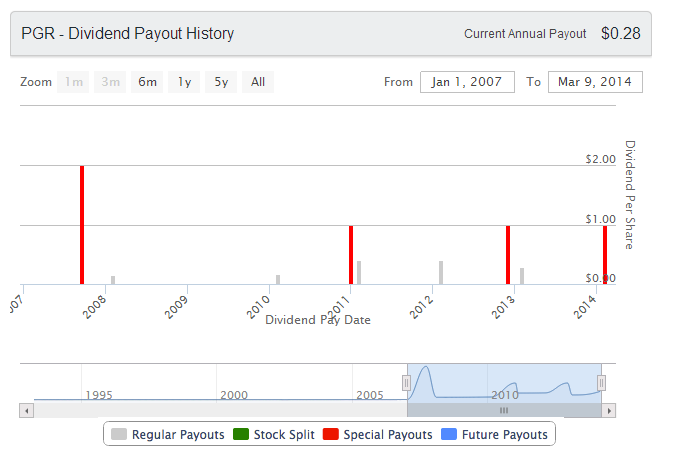
2. Carnival Corp (CCL)
- When: 12/28/2012
- How Much: $0.50 per share
- Full Payout History
Another move spawned by the threatening tax increase, Carnival declared a special dividend that was twice the company’s regular payout to both reward its investors and help save Carnival from hefty tax burdens in the future.
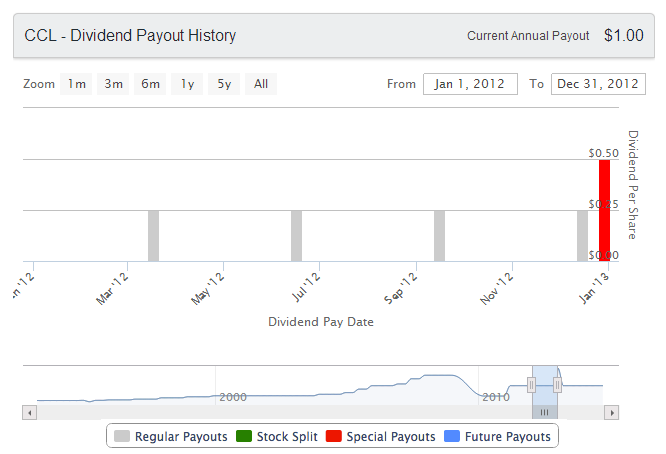
3. Whole Foods (WFM)
- When: 12/21/2012
- How Much: $1 per share
- Full Payout History
Though it was not specifically cited, it is more than likely that Whole Foods followed suit and issued a special dividend prior to the Fiscal Cliff. The payout was substantially higher than the company’s normal dividend payments, which had been just $0.07/quarter for the prior year.
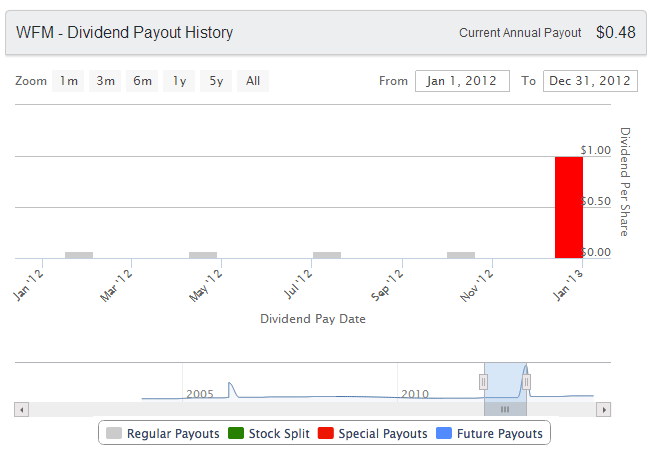
4. Franklin Resources (BEN )
- When: Multiple
- How Much: $0.6667 to $1 per share
- Full Payout History
Franklin resources has increased its dividend for 32 consecutive years, and over that time the company has made four special dividend payouts: 4/15/2005 ($0.6667/share), 12/31/2009 ($1/share), 12/30/2011 ($0.6667/share), and 12/20/2012 ($1/share), sneaking in a final payout prior to the Fiscal Cliff.
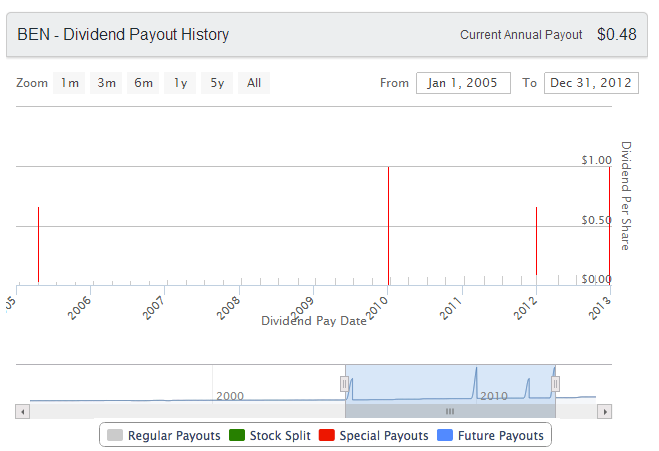
5. Costco (COST )
- When: 12/18/2012
- How Much: $7 per share
- Full Payout History
A number of companies made special dividends at the end of 2012. With the Fiscal Cliff looming and capital gains taxes set to rise for certain tax brackets, Costco laid out a $3 billion special dividend that got shareholders in a frenzy. Other firms participated in a similar fashion or moved their regular dividend payment back to December to give investors a more favorable tax treatment.
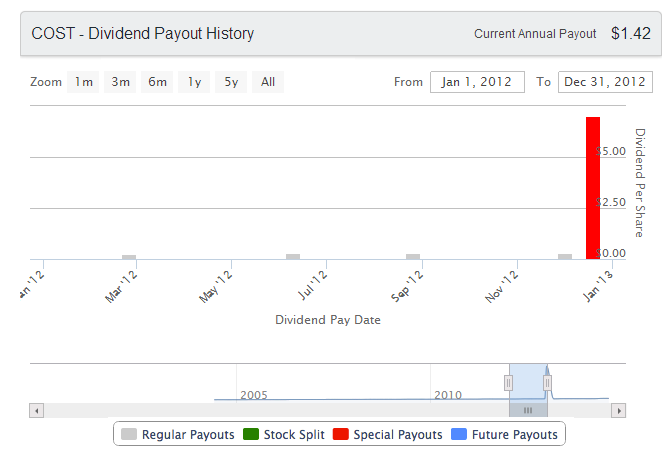
6. Las Vegas Sands (LVS )
- When: 12/18/2012
- How Much: $2.75 per share
- Full Payout History
According to the company, this special payout came about because of the “unique position” and success it had enjoyed that year, but the timing is too coincidental to not be related to the Fiscal Cliff. The payout was more than 10-times its normal dividend of $0.25 per quarter.
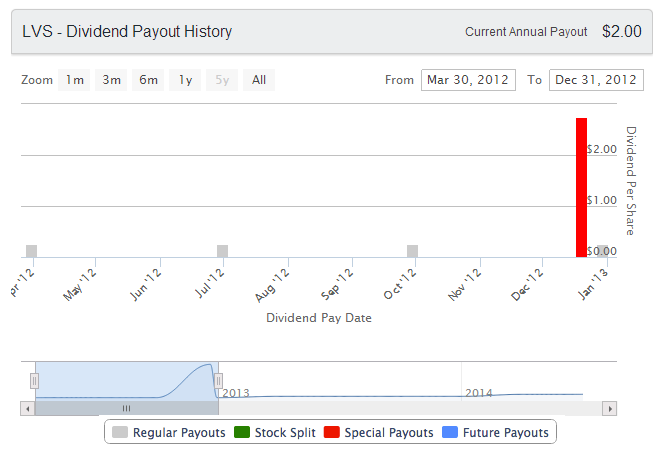
7. Wendy’s Company (WEN )
- When: Multiple in 2006
- How Much: $0.15 per share
- Full Payout History
Wendy’s made a series of special dividends throughout 2006 while still maintaining its regular payout. All-in-all, the company made 11 separate payouts to investors in 2006 (including special and regular payouts). The special dividends fell on 3/1/2006, 7/14/2006, and 12/20/2006, all of which amounted to $0.15 per share.
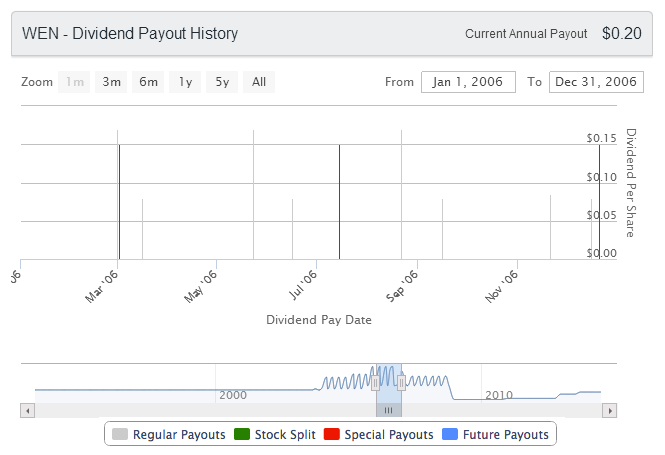
8. Microsoft (MSFT )
- When: 12/2/2004
- How Much: $3 per share
- Full Payout History
In a monumental move, Microsoft declared a special dividend that was worth a total of $32 billion while also announcing a four-year $30 billion share repurchase program. It also doubled its regular dividend payout at the same time. As growth began to slow and it became harder to make acquisitions while complying with antitrust laws, Microsoft decided to put its $60 billion cash pile to work and pay out this massive special dividend.

The Bottom Line
There is no way of knowing if a company is going to or will ever pay out a special dividend. When investing in dividend stocks, the typical factors like relative strength, overall dividend yield attractiveness, dividend reliability, dividend uptrend, and earnings growth should be taken into account to determine what course of action to take. The potential for special dividends is just an added bonus that a shareholder might see down the road.
Be sure to visit our complete recommended list of the Best Dividend Stocks, as well as a detailed explanation of our ratings system here.





